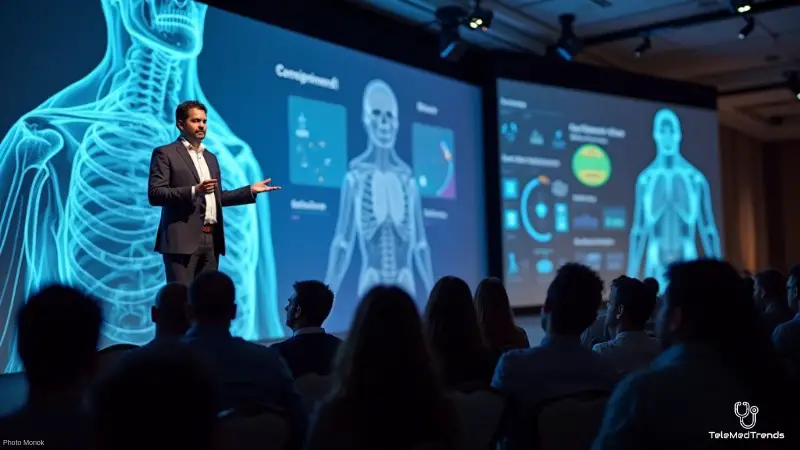At the recently concluded STAI 2025 conference, industry leaders and experts gathered to explore the rapid transformation of healthcare through generative technology. Among the standout moments was the keynote address by Meethun Panda, a renowned strategist in healthcare innovation. His presentation, titled “Generative Strategy for Healthcare and Life Sciences,” provided valuable insights into how these emerging tools are revolutionizing the industry.
Panda’s contributions to the field earned him the “Industry Leader in Artificial Intelligence Award” at the conference, recognizing his efforts in pushing the boundaries of technological advancements in medicine. His talk explored real-world applications of generative models, their impact on healthcare, and the challenges that must be addressed for their widespread adoption.
Key Takeaways
Generative technology is revolutionizing healthcare by speeding up drug discovery, tailoring medicine to individual needs, and tackling privacy issues.
- Generative models dramatically accelerate the drug development process, cutting timelines from years to months.
- Customized treatment plans are becoming more precise by analyzing individual genetic profiles and medical histories.
- Privacy-centric frameworks, such as federated learning, are essential for safeguarding sensitive patient data while supporting research.
Accelerating drug discovery and treatment
One of the most significant ways generative technology is transforming healthcare is in drug development. Traditional drug discovery is a lengthy and expensive process, often taking years to move from research to clinical trials. By analyzing vast datasets and simulating molecular interactions, generative models help researchers identify new drug compounds much faster, reducing the time it takes to bring effective treatments to market.
He also highlighted a case study from Pfizer, where researchers used generative models to generate novel drug compounds. This approach significantly shortened the development timeline, compressing a process that typically spans years into mere months. Such advancements are opening doors for faster responses to global health crises and rare diseases that previously lacked viable treatment options.
Generative models are also making strides in personalized medicine. By analyzing an individual’s genetic profile, lifestyle, and medical history, these tools can help doctors tailor treatment plans to specific patient needs. This level of precision improves outcomes, reduces unnecessary treatments, and minimizes side effects.
Another example of advancements in drug development is using digital twins—virtual patient models that enable healthcare providers to simulate various treatment scenarios before making real-world decisions. By leveraging these simulations, medical professionals can fine-tune treatment strategies, ensuring the most effective and personalized interventions for each patient.
Knowing privacy, regulations, and ethical concerns
While the benefits of generative tools in healthcare are evident, their adoption is not without challenges. One of the most pressing concerns is data privacy and regulatory compliance.
With laws like HIPAA in the United States and GDPR in Europe enforcing strict guidelines on patient data protection, hospitals and research institutions must ensure that these technologies adhere to security and privacy regulations.
Panda stressed that healthcare organizations must prioritize privacy-first architectures, such as federated learning, which allows data to be analyzed without being moved or exposed. This ensures that sensitive medical records remain protected while still enabling valuable insights for research and treatment development.
Another critical issue is bias in medical data. Generative models rely on the data they are trained on, and if those datasets lack diversity, they risk reinforcing existing healthcare disparities. Panda pointed out that historically underrepresented groups often receive suboptimal medical care due to gaps in available data. If unchecked, these biases could lead to inaccurate predictions and worsen health inequalities.
Addressing this issue requires transparent and diverse data collection methods, ensuring that all patient groups are fairly represented. Panda emphasized the need for rigorous oversight and ethical governance frameworks that monitor how these technologies are used in practice.
Additionally, integrating new systems with existing legacy infrastructure remains a significant hurdle. Many hospitals still rely on outdated technology that struggles to accommodate advanced solutions. Upgrading these systems requires substantial investment and careful implementation to ensure seamless operation without disrupting patient care.
A guide map for the future of healthcare
To tackle these challenges, Panda laid out a clear strategy for healthcare leaders aiming to integrate generative technology effectively. He stressed the importance of focusing on areas where these tools can make the biggest impact, such as drug discovery and diagnostics, while ensuring that data privacy remains a top priority. Updating outdated hospital systems is crucial for a smooth transition, as is building ethical guidelines to prevent bias and ensure fair treatment for all patients.
Panda also highlighted the need for collaboration among healthcare providers, tech experts, and policymakers to create a balanced approach that prioritizes both innovation and patient safety. Looking ahead, he sees a future where hospitals move from simply treating illnesses to predicting and preventing them, thanks to self-learning models and real-time patient monitoring.
A new era in medical innovation
As the healthcare industry continues its journey toward full integration with generative technology, the possibilities for improved patient care, efficiency, and innovation are expanding rapidly. The STAI 2025 conference highlighted the remarkable progress already being made, while also addressing the challenges that must be overcome to ensure responsible and ethical implementation.
Panda’s presentation underscored the delicate balance between technological progress and patient welfare. While these advancements promise a future of faster drug development, more accurate diagnostics, and personalized treatments, they must be developed and deployed with caution, ensuring they serve all communities fairly.
The growing adoption of generative models in healthcare is more than just a trend—it is a fundamental shift in how medicine is practiced. With careful regulation, investment, and strategic implementation, the industry stands on the brink of a new era in medical innovation, one that could reshape healthcare for generations to come.






